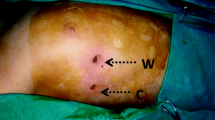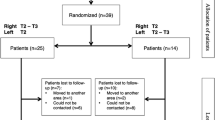Abstract
Objective
To evaluate and compare the immediate and long-term outcomes of videothoracoscopic T2–T4 sympathectomy and T3–T4 sympathicotomy for the treatment of palmar and axillary hyperhidrosis.
Methods
Between October 1993 and September 2007, we treated a total of 88 patients affected by palmar and axillary hyperhidrosis. Twenty-four patients underwent T2–T4 sympathectomy with 5–10 mm trocars (Group A), 43 T2–T4 sympathectomy with 2–5 mm trocars (Group B), 15 T3–T4 sympathicotomy with 5–10 mm trocars and 6 T3–T4 ganglion block with 2–5 mm trocars (Group C). The mean operative time, for each side, was 15 min for sympathicotomy and 28 min for sympathectomy. In September 2008, we recontacted 98% of patients (total 86), by telephone, to establish long-term results (follow-up range 1–15 years).
Results
In this series, we did not find any significant difference between T2–T4 sympathectomy and T3–T4 sympathicotomy in terms of postsurgical palmar anhidrosis or onset of compensatory hyperhidrosis, while both methods show high efficacy for remission of palmar hyperhidrosis. The slightly higher recurrence rate in our early experience (Group A) can be attributed to the learning curve. Using smaller trocars (2–5 mm), we reduced postsurgical intercostal pain and obtained better aesthetic results and a higher grade of patient’s satisfaction.
Interpretation
Thoracoscopic approach to hyperhidrosis has evolved in the last few decades with a consequent decrease in side effects. In this series, all patients experienced an improvement in quality of life even in case of recurrence or onset of compensatory hyperhidrosis. Due to these results, the shorter operative time and easier performance of sympathicotomy, we prefer this method.
Similar content being viewed by others
References
Yoon SH, Rim DC (2003) The selective T3 sympathicotomy in patients with essential palmar hyperhidrosis. Acta Neurochir 145:467–471
Drott C, Göthberg G, Claes G (1995) Endoscopic transthoracic sympathectomy: an efficient and safe method for the treatment of hyperhidrosis. J Am Acad Dermatol 33:78–81
Lin TS, Wang NP, Huang LC (2001) Pitfalls and complications avoidance associated with transthoracic endoscopic sympathectomy for primary hyperhidrosis (analysis of 2200 cases). Int J Surg Invest 2(5):377–385
Chiou SM, Chen SC (1999) Sensitivity, specificity and predictive value of intra-operative elevation of hand temperature to ensure a successful T2-sympathectomy in patients with palmar hyperhidrosis. Acta Neurochir 141:855–859
Cohen Z, Levi I, Pinsk I, Mares AJ (1998) Thoracoscopic upper thoracic sympathectomy for primary palmar hyperhidrosis: the combined paediatric, adolescents, and adult experience. Eur J Surg 164(Suppl 580):5–8
Hashmonai M, Kopelman D, Ehrenreich M, Assala A (1998) The learning curve of thoracoscopic sympathectomy. In: Montori A, Lirici MM, Montori J (eds) Proceedings of 6th world congress of endoscopic surgery. Monduzzi Editore, Bologna, pp 1147–1151
Loscertales J, Arroyo Tristan A, Loscertales Congregado M (2004) Tratamiento de la hiperhidrosis palmar por simpatectomia toracica. Resultados inmediatos y calidad de la vida postoperatoria. Arch Broncopneumol 40:67–71
Yano M, Kiriyama M, Fukai I, Sasaki H, Kobayashi Y, Mizuno K, Haneda H, Suzuki E, Endo K, Fujii Y (2005) Endoscopic thoracic sympathectomy for palmar hyperhidrosis: efficacy of T2 and T3 ganglion resection. Surgery 138:40–45
De Campos JR, Kauffman P, Werebe Ede C, Andrade Filho LO, Kusniek S, Wolosker N, Jatene FB (2003) Quality of life, before and after thoracic sympathectomy: report on 378 operated patients. Ann Thorac Surg 76(3):886–891
Wilson MJ, Magee TR, Galland RB, Dehn TC (2005) Results of thoracoscopic sympathectomy for the treatment of axillary and palmar hyperhidrosis with respect to compensatory hyperhidrosis and dry hands. Surg Endosc 19:254–256
Shelley W, Florence R (1960) Compensatory hyperhidrosis after sympathectomy. N Engl J Med 24:1056–1058
Rennie JA (1996) Compensatory sweating an avoidable complication of thoracoscopic sympathectomy? Minim Invasive Ther Allied Technol 5:101
Bonjer HJ, Hamming JF, DuBois NAJJ (1996) Advantage of limited thoracoscopic sympathectomy. Surg Endosc 10:721–723
Yoon DH, Ha Y, Park YG, Chang JW (2003) Thoracoscopic limited T-3 sympathectomy for primary hyperhidrosis: prevention for compensatory hyperhidrosis. J Neurosurg 99:39–43
Leseche G, Castier Y, Thabut G (2003) Endoscopic transthoracic sympathectomy for upper limb hyperhidrosis: limited sympathectomy does not reduce postoperative compensatory sweating. J Vasc Surg 37:124–128
Göthberg G, Drott C, Claes G (1994) Thoracoscopic sympathicotomy for hyperhidrosis: surgical technique, complications and side effects. Eur J Surg 160:51–53
Lee DY, Yoon YH, Hong YJ, Moon DS (1998) Needle thoracoscopic sympathectomy for essential hyperhidrosis. Korean J Thorac Cardiovasc Surg 31:598–603
Rex LO, Drott C, Claes G, Göthberg G, Dalman P (1998) The Boras experience of endoscopic thoracic sympathicotomy for palmar, axillary, facial hyperhidrosis and facial blushing. Eur J Surg 164:23–26
Lin CC, Telaranta T (2001) Lin–Telaranta classification: the importance of different procedures for different indications in sympathetic surgery. Ann Chir Gynaecol 90:161–166
Neumayer C, Zacherl J, Holak G, Függer R, Jakesz R, Herbst F, Bischof G (2004) Limited endoscopic thoracic sympathetic block for hyperhidrosis of the upper limb. Surg Endosc 18:152–156
Gossot D, Galetta D, Pascal A, Debrosse D, Caliandro R, Girard P, Stern JB, Grunenwald D (2003) Long-term results of endoscopic thoracic sympathectomy for upper limb hyperhidrosis. Ann Thorac Surg 75:1075–1079
Weksler B, Blaine G, Souza ZBB, Gavina R (2009) Transection of more than one sympathetic chain ganglion for hyperhidrosis increases the severity of compensatory hyperhidrosis and decreases patient satisfaction. J Surg Res 156:110–115
Denny-Brown D, Brenner C (1944) Lesion in peripheral nerve resulting from compression by spring clip. Arch Neurol Psychiatry 52:1–9
Lin CC, Mo LR, Lee LS, Ng SM, Hwang MH (1998) Thoracoscopic T2-sympathetic block by clipping—a better and reversible operation for treatment of hyperhidrosis palmaris: experience with 326 cases. Eur J Surg 164:13–16
Lin TS, Chou MC (2004) Treatment of palmar hyperhidrosis using needlescopic T2 sympathetic block by clipping: analysis of 102 cases. Int Surg 89:198–201
Choi CB, Lee CY, Sim SB (2003) Treatment of palmar hyperhidrosis by endoscopic clipping of the upper part of the sympathetic ganglion. Clin Auton Res 13:48–51
Lin TS, Huang LC, Wang NP, Chang CC (2001) Endoscopic thoracic sympathetic block by clipping for palmar and axillary hyperhidrosis in children and adolescents. Pediatr Surg Int 17:535–537
Kim WO, Kil HK, Yoon KB, Noh KN (2009) Botulinum toxin: a treatment for compensatory hyperhidrosis in the trunk. Dermatol Surg 35:833–838
Westphal FL, De Campos JRM, Ribas J, De Lima LC, Lima Netto JC, Da Silva MS, Westphal DC (2009) Skin depigmentation: could it be a complication caused by thoracic sympathectomy? Ann Thorac Surg 88:e42–e43
Conflict of interest
None.
Author information
Authors and Affiliations
Corresponding author
Rights and permissions
About this article
Cite this article
Scognamillo, F., Serventi, F., Attene, F. et al. T2–T4 sympathectomy versus T3–T4 sympathicotomy for palmar and axillary hyperhidrosis. Clin Auton Res 21, 97–102 (2011). https://doi.org/10.1007/s10286-010-0110-6
Received:
Accepted:
Published:
Issue Date:
DOI: https://doi.org/10.1007/s10286-010-0110-6




